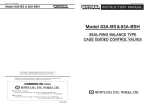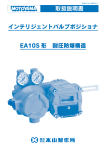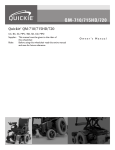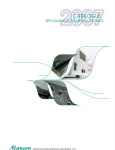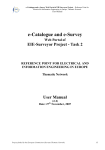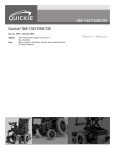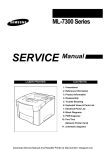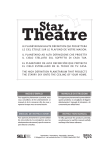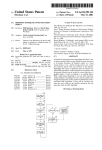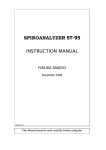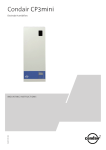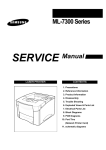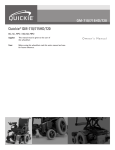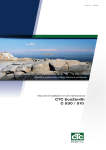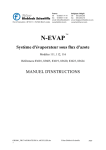Download USER`S MANUAL
Transcript
Bulletin No. MIE-B3001P INSTRUCTION MANUAL USER’ S MANUAL Model 01, 05, 83A, 83, 89 Globe Type Control Valves USER’ S MANUAL Model 01, 05, 83A, 83, 89 Introduction Thank your very much for choosing MOTOYAMA Control Valves. To use this product safely and to optimize its performance, it is recommended that following instruction should be read carefully and followed. 1 General ① Keep this instruction manual in operator’s hand. ② Before using Control Valves, read this instruction manual carefully and fully understand it for operation. ③ This instruction manual does not cover Accessories installed to Control Valves. Kindly refer appropriate Accessories’ Instruction Manual along with this manual. 2 For Safety Use To use this Control Valves safely, this instruction manual describes symbols and signal terms in accordance with JIS Z2901 and ANSI Z5351 which shall call your attention to keep safety manner or to give caution of handling, together with notes. Important information has been marked and emphasized with following symbols in this Instruction Manual. Symbols and Signal Terms Explanation WARNING A direct endangerment of a person’s health or life may occur if the Warning was not observed. CAUTION If the Caution was not observed, minor personal injuries and/or property damages may result. 3 Note MOTOYAMA is continuously improving and upgrading its products design, specifications and/or dimensions. Information included herein is subject to change without notice. MOTOYAMA ENG. WORKS, LTD. SHALL NOT BE LIABLE FOR TECHNICAL OR EDITORIAL ERRORS OR OMISSIONS CONTAINED HEREIN; NOR FOR INCIDENTAL OR CONSEQUENTIAL DAMAGES RESULTING FROM THE FURNISHING, PERFORMANCE, OR USE OF THIS MATERIAL. i Model 01, 05, 83A, 83, 89 Transportation, Unpacking, Check and Storage 1 Transportation CAUTION When loading or unloading and transportation of Control valves, pay full attention not to drop or not to give shock with hitting or bumping etc. It would make Valves and its accessories mechanical troubles or damages as of precision instrument. ◆ If any cautions/instructions or care marks are indicated on package, follow them as it is. 2 Unpacking (1) There are two types of packages used for Control Valves, wooden crate/box and carton. In either case, unpack crate/box or carton indoor or in warehouse. CAUTION Never unpack package of Control Valves outdoor place where rain falls, on damp and wet ground and/or dust is in the air. It would make the Valves and its accessories mechanical troubles or damage because of precision. (2) When unpacking the wooden box, follow the procedure described below unless otherwise specified. ① Pull off round pegs around edge protectors at each corner and remove them. ② Pull off round pegs stuck on roof (top) and remove the roof (top). ③ Remove waterproofing materials, if applied, inside of the box. ④ Pull off round pegs stuck on frame at side and remove side plates. ⑤ Pull off round pegs stuck on frame at end and remove end plates. ⑥ If the goods are fixed with square-lumbers or bolts and nuts, remove them. ⑦ Remove waterproofing materials such as polyvinyl packing covering the goods. Edge protector Roof (Top) plate T-form peg Side plate End plate 【Note】T-form pegs are not required to be pull off when unpacking. ii Round peg Model 01, 05, 83A, 83, 89 3 Check of Products 【Caution】After receiving goods, unpack package promptly and check if goods delivered are complying with your order specification. ① When taking out goods from box, pay attention not to give any physical shock to Accessories attached to Valves. Take out spare parts if they are enclosed. ② Check Name Plate attached to Yoke of Actuator whether Valve specification complying with your request. ③ If any clarification required on received goods, please contact MOTOYAMA sales office specifying Serial Numbers and Model Number indicating on Name Plate attached to the Valves. 4 Storage ① If goods need to be stored before installation, store goods in warehouse or equivalent indoor storage facility, covering whole goods with cover like polyethylene sheet and protect goods from high temperature, moisture, Dust and vibration etc. CAUTION During storage of goods, protect Conduit connection of electrical instrument from moisture or water which would give breakdown of electricity and cause trouble on products. ② If a period of storage is exceeding one (1) year after delivery, re-calibration of Valve action and check of gland and gasket leakage before installation shall be required. Please contact MOTOYAMA sales office when re-calibration is requested. iii Model 01, 05, 83A, 83, 89 CONTENTS Page 1. Purpose of this Instruction Manual ………………………………………………………01 2. Application and Construction 2.1 Purpose of Use …………………………………………………………………………… 02 2.2 Construction ………………………………………………………………………………… 02 2.3 Specification………………………………………………………………………………… 02 3. Installation 3.1 General ……………………………………………………………………………………… 04 3.2 Installation on System Piping …………………………………………………………… 05 3.3 Inspection after Installation ……………………………………………………………… 05 4. Operation, Maintenance and Check 4.1 Precautions and Check before Operation ……………………………………………… 06 4.2 Greasing to the Gland Packing …………………………………………………………… 07 4.3 Maintenance and Check ………………………………………………………………… 08 5. Disassembly & Assembly 5.1 Split of Actuator from Valve Body………………………………………………………… 09 5.2 Disassembling and Re-assembling of Valve Body …………………………………… 10 5.3 Disassembling and Re-assembling Model 3800 Actuator …………………………… 14 5.4 Disassembling and Re-assembling Model 2800 Actuator …………………………… 18 6. Adjustment and Test 6.1 Adjustment ………………………………………………………………………………… 21 6.2 Test ………………………………………………………………………………………… 23 7. Change of Valve Action and Actuator 7.1 Purpose……………………………………………………………………………………… 23 7.2 Change of Valve Action …………………………………………………………………… 23 7.3 Change of Stroke and Spring Range …………………………………………………… 24 8. Hand Wheel Mounted on Actuator 8.1 Operating, Disassembling and Re-assembling of Side-Mounted Handwheel ……… 26 8.2 Operating, Disassembling and Re-assembling of Top-Mounted Handwheel ……… 29 9. Travel Stopper On Actuator 9.1 Classification ……………………………………………………………………………… 31 9.2 Adjustment of Travel Stopper …………………………………………………………… 31 10. Bellows Seal Type Valve 10.1 Split of Actuator from Valve Body ……………………………………………………… 34 10.2 Disassembling and Re-assembling of Formed Bellows Assembly ………………… 35 10.3 Disassembling and Re-assembling of Welded Bellows Assembly ………………… 36 10.4 Connection and Adjustment of Valve Stem …………………………………………… 36 11. Trouble Shooting …………………………………………………………………………… 38 12. Recommended Spare Parts ……………………………………………………………… 40 13. Disposal of Control Valves and Parts …………………………………………………… 40 Reference Data (Estimated Life Cycle of Control Valve Parts) ………………………… 41 iv Model 01, 05, 83A, 83, 89 1 Purpose of this Instruction Manual (1) This Instruction Manual provides essential information for optimizing MOTOYAMA Control Valves, Model #01/#05 Bottom Guided and Single-seated/ Double-seated Globe Valves, #83A, #83 Cage Guided Globe Valves and #89 Top Guided and Single Seated Globe Valves. (2) Read this manual carefully before installing, operating or overhauling MOTOYAMA Diaphragm Globe Type Control Valves (Model #01, #05, #83A, #83 and #89), read this manual carefully. (3) Together with this manual, read following Accessories’ manuals before using, when applicable. Valves and Accessories Bulletin No. Model EA10S Intelligent Valve Positioner MIE-B6111 Model EA91A and EA90A Electro-Pneumatic Valve Positioner MIE-B6104 Model PA92A Pneumatic Valve Positioner MIE-B2008 Model MR2000 Air Filter Regulator MIE-B6903 Model 83A-BS and 83A-BSH Seal-Ring Balance Type Cage Guided Control Valves MIE-B4301 (4) If any other Accessories are installed on Valves delivered, kindly request our sales office appropriate Instruction Manual, if necessary. 1 Model 01, 05, 83A, 83, 89 2 Application and Construction 2.1 Purpose of Use Model 01, 05, 83A, 83 and 89 Control Valves are installed in process piping and used to control process flow, activating Valve Plug open and close or throttling replying control signal such as 4 ∼ 20mA DC or 20 ∼ 100kPa from controller of instrumentation system, to keep the flow specific and/or constant process conditions. 2.2 Construction Model 01, 05, 83A, 83 and 89 consist of Body Assembly and Actuator Assembly. Body has controlling mechanism actually control the process flow and Actuator has driving mechanism to activate Valve Plug receiving air power source. Fig. 2-1 show typical constructions of Globe Type Control Valves. Body Assembly including valve Body, Bonnet, Bottom Cover are jointed together with Studs, Nuts and Gaskets, provides pressure container parts where process flow runs though or stays. Valve Plug is hold by Guide Bush or Cage and is kept at proper control position flowing to the control signal to Actuator. Spring Loaded Diaphragm Actuator converts variation of air pressure into thrust power for axial motion by the balance of Diaphragm and Spring and keeps or controls the Plug opening at proper position. 2.3 Specification See individual catalogue for following Models. Valve Model 01 MCE-B1101 05 MCE-B1501 83A (150, 300, 600LB) MCE-B4306 83A-BS, 83A-BSH MCE-B4307 83 (900, 1500LB) MCE-B4302 89 MCE-B4102 CAUTION 2 Bulletin No. Do not use the products beyond the selected specification, code, standard and/or regulations to secure the safety of the delivered products. Model 01, 05, 83A, 83, 89 Fig. 2-1 Globe Type Control Valves (a) Globe Type Single Seated Control Valve Top and Bottom Guide Type (b) Globe Type Double Seated Control Valve Top and Bottom Guide Type Model 3801 (Direct Action) Model 3805 (Direct Action) (c) Cage Guide Type Control Valve Model 3883A, 3883 (Direct Action) (d) Globe Type Single Seated Control Valve Top Guide Type Model 3889 (Direct Action) 3 Model 01, 05, 83A, 83, 89 3 Installation 3.1 General In general, Control Valves shall be installed in vertical to piping line or Valve Stem to be vertical to the ground. ① Keep sufficient space to the Valves to be accessible to operate safely and to make maintenance work, inspection and testing easily. ② Eye-Bolts (Nuts) on Diaphragm case assembly must be used only for hanging Actuator assembly. Do not hang up complete Valves using Eye-Bolts after assembling Body and Actuator. In any case, following mass shall not be exceeded to hang up. [Unit : kg] Actuator Model No. 3800 CAUTION 2800 Actuator Size Allowable Hung Up Mass Actuator Masses N24 80 12 N28 150 15 N33S 150 24 N40 220 51 500 S/L 220 85 / 102 (Note 2) 650 S/L 900 (Note 3) 270 / 275 (Note 2) 650X S/L 900 (Note 3) 365 / 395 (Note 2) 【Notes】 (1) See catalogues for each Valves masses. (2) Actuator mass is for direct action. (3) Only when using four (4) Eye-Bolts for 650S/L and 650XS/L Actuator. Other size of Actuator, allowable lifting load is permissible using two (2) Eye-Bolts. ③ Ambient temperature and humidity for Valves should be − 20˚C ∼+ 70˚C, and be less than 90% RH. WARNING 4 Never use Valves on service condition exceeding rating and standard of connection to prevent Valves from damage, breakage and/or leakage. Model 01, 05, 83A, 83, 89 3.2 Installation on System Piping (1) Remove all welding chips, scales and other foreign matters from internal of the piping line before installing Valves in between. (2) Be sure to match arrow mark on Valve Body to the flow direction when installing. (3) Piping Gasket shall be installed properly not to be stuck out into Body bore diameter. (4) Be sure the concentricity and parallelism of Valve inlet and outlet piping are correct. Tighten Bolts and Nuts equally. Be sure not to give the excessive stress to Valves. CAUTION ① When tightening, be sure not to give excessive load (piping stress) to Valves which would cause damage, deformation and leakage. ② Either Body or Actuator, or both, should be supported by proper way. (5) Blow off scales, rust and foreign matters in pneumatic piping by compressed Air before connecting pneumatic piping to Actuator and accessories. (6) Refer to each instruction manuals for wiring conduits of electric equipments. (7) For Finned or Extension Bonnet Valves, do not cover Bonnet with heating or cooling insulation. 3.3 Inspection after Installation (1) Carry out leakage test to check leakage from connection piping. (2) Check leakage from Gland or Gasket after test pressure is applied to the piping. If any leakage is found, reduce pressure and retighten Gland Nuts or Stud Nuts with equally. CAUTION ① If more than 6 months past before starting operation of system, retighten Gland Nuts before starting pressure tightness test. ② After re-tighten Gland Nuts, reciprocate the Valves at least 10 times from fully open to fully close to fit Gland Packing for operation. 5 Model 01, 05, 83A, 83, 89 4 Operation, Maintenance and Check 4.1 Precautions and Check before Operation (1) Spring range and Off-balance for Model 2800 series Actuator is adjusted properly to the required specification when shipped. Do not turn Adjusting Screw unless otherwise it should be. (2) Before start operation, check Stem Nuts, Actuator Bolts and Nuts and other screws to be tightened. Re-tighten if necessary. (3) Some Gland Packing might have leakage because of stress relaxation. Check tightness of Gland Nuts and re-tighten if necessary. (4) When Lubricator is equipped on Bonnet (page 7 and 8), check if Grease filled enough. Be sure to close Stop Valve after filling Grease. See Table 4-1 to select appropriate Grease for each service. Please contact MOTOYAMA sales office when replacement Grease is required. CAUTION ① If more than 6 months past before starting operation of system, re-tighten Gland Nuts before starting pressure tightness test. ② After re-tighten Gland Nuts, reciprocate the Valves at least 10 times from fully open to fully close to fit Gland Packing for operation. Table 4-1 Grease Climax Lubricants & Equipment Co.® Maker Three Bond Co., LTD Grease No. #400 #650 #750 #1901 Operating Temp. (˚C) − 29 ∼+ 230 − 40 ∼+ 260 0 ∼+ 300 + 300 ∼ Color Red Black Black Services Blue Amine Chloride Acetylene Asphalt Steam Acid Chlorine Vinyl Coke oven gas General high Alkali Food Chloride Coal tar temperature fluid Alcohol Bleach General Gas Steam Ammonia Cyanide Hydrocarbon Phosphorus Brine Milk Mineral Oil Water Sulfur Paints Freon Shape Stick Stick Stick Bulk(Can) 【Note】No Lubricator is installed for services fluid temperature is lower than −40˚C or higher than +450˚C or the pressure rating is Class 2500LB or greater. (5) When Handwheel is mounted, be sure Handle is set to “Neutral” or auto operation position which does not restrain Valve opening. (6) Carry out loop test with Controller to check that Valves open or close smoothly. 6 Model 01, 05, 83A, 83, 89 CAUTION ① If Valves must be heated up, increase temperature and pressure gradually without changing them rapidly. ② Heating up speed shall be less than 150˚C/Hr for Model 01, Model 05, Model 89 and shall be less than 100˚C/Hr for Model 83A, Model 83. ③ During heating up, be sure to avoid sudden operation. 4.2 Greasing to the Gland Packing (1) To use Braided Packing, it is required to use Greases to elevate the sealing and lubricating property on Valve Stem. (2) Greasing device to inject the Grease is called Lubricator. See Fig. 4-1 for details of Lubricator. (3) To supply Grease in routine work, follow the procedure below. ① Turn Handle clockwise to make Spindle closed. (If Pressure Screw is removed holding Spindle open, Grease may flow out reversely by internal pressure from Valve Body.) ② Take out Pressure Screw from Cylinder. ③ Insert designated Grease from this open port. Use designated Grease specified on Name Plate attached on Actuator ④ Compress Grease into Lubricator by Pressure Screw. ⑤ Under compressing Grease by Pressure Screw, turn Handle counter-clockwise to make Spindle open. Then compress Grease further by Pressure Screw. After compressing, turn Handle clockwise and close Spindle. • Repeat above operation ③, ④, ⑤ several times and fill Grease into Connection Pipe and Cylinder. CAUTION Do not fill Grease to strong or too much to prevent over flow from Bonnet Staffing Box or to prevent the damage of Gland Packing itself. Pay attention over flow from Staffing Box, Guide Bush and/or Valve Stem when greasing. ⑥ Turn Handle clockwise to make Spindle closed and Greasing is completed. ⑦ After greasing, open and close the Valves several times (around 10 times) to create uniformed grease film Abetween Gland Packing and Valve Stem. 7 Model 01, 05, 83A, 83, 89 Fig. 4-1 Lubricator No. Part Name ① Body ② Bonnet ③ Spindle ④ Gland nut ⑤ Handle wheel ⑥ ⑦ No. Part Name ① Body ② Bonnet ③ Spindle ④ Gland nut ⑤ Handle wheel Washer ⑥ Washer Lock nut ⑦ Lock nut ⑧ Connection pipe ⑧ Connection pipe ⑨ Cylinder ⑨ Cylinder ⑩ Pressure screw ⑩ Pressure screw ⑪ Gasket ⑪ Gasket ⑫ O ring ⑫ Packing ring ⑬ Gland packing ⑭ Gland bushiuy For low pressure (600LB or lower) For high pressure (900,1500LB) 4.3 Maintenance and Check To maintain maximum efficiency on Control Valves, it is recommended to check or proceed maintenance work as follows. (See Paragraph 11. Trouble shooting on page 38 ∼ 39) (1) Daily Check Check leakage, abnormal sound, vibration and/or hunting (2) Periodical Check ...... [Annually] Check each part of Valves, re-tighten Gland and replenish/replace Grease if necessary. (3) Overhaul ...... [Body: Once in every 2 years, Actuator: Once in every 5 years] Disassemble Valves and check internal parts. (See Chapter 5) WARNING 8 When leakage is found from the Valve or piping, Do Not Touch or Access to the fluid until the safety is confirmed by proper responsible person. Model 01, 05, 83A, 83, 89 5 Disassembly & Assembly Following is recommended procedure to disassemble or re-assemble valves. CAUTION ① Please prepare following spare parts available before disassembly: Gland Packing, Gasket Packing. (Do not reuse the used Gland Packing, Gasket Packing.) ② Prepare required Tools in advance. ③ Never disassemble Valves on system under existing inside pressure or before cooling down of Valves completely. ④ Do not turn Valve Stem when Valve is closed. ⑤ On Model 2800 spring diaphragm Actuator, Do Not Turn Spring Adjuster. Turning of Spring Adjuster makes change of Spring Range limit, upper and lower. 5.1 Split of Actuator from Valve Body (See. Fig. 5-1) WARNING To disassemble Valves on system line, Close the line and Release all the system pressure in advance. (1) Place fitting mark on each connecting parts before disassembling. (2) Hold Valve Plug at full open position depressurizing supply pressure to zero on direct action Actuator or supplying Air pressure on reverse action Actuator. (3) Loosen Stem Nut and Pointer together and go downward, then lock. On Actuator size N33 and larger, lower Locking Plate together. Thread size of Valve Stem and Top Stem is as follows. Actuator size Fig. 5-1 Removing Actuator Thread N28 M9, P1.25 N33 M12, P1.75 N40 M18, P2.0 500 W3/4-10 650 W7/8-9 Top Stem Stem Nut Pointer Stem Nut Yoke Nut (4) Turn the stem nut to lower the valve stem and remove the valve stem from the top stem. (5) Loosen and remove the yoke nut (yoke bolt). (6) Lift the actuator stralght up and remove it from the valve Valve stem body. 9 Model 01, 05, 83A, 83, 89 5.2 Disassembling and Re-assembling of Valve Body To disassembling or re-assembling Valve Body, follow the procedure below. (See Fig. 5-2 ∼ 5-6). 5.2.1 Disassembling Procedure (1) Remove Stud Bolt Nuts. (2) Pull up Valve Plug together with Bonnet upright and split it from Valve Body. (3) Loosen Bottom Cover Clamping Nuts and remove Bottom Cover. (4) Loosen Gland Nuts and release the tension of Gland Packing. (5) Pull down Valve Plug from Bonnet. CAUTION For Models 01 and 05, with push-down open Bodies, remove ① Bottom Cover, ② Valve Plug and ③ Bonnet in order. (6) Remove Gland Bushing, Gland Packing, Lantern Ring and Packing Ring from Bonnet gland. (7) To remove the Seat-Ring (only when required), a special tool is required. (8) For Cage Guide Type Control Valves (Model 83A, Model 83), remove Cage from the Body. 5.2.2 Inspection of the Parts After disassembling, each parts should be cleaned and checked as follows. (1) Check seat surface of Seat-Ring on Valve Body, Valve Plug, Guide and Cage to be free from any damage and/or deformation. (2) Check Body and Bonnet wall thickness decreased. Check Body and Bonnet sealing surface of Gasket Packing and Gland Packing to be free from any damage and/or deformation. (3) Check the appearance of Valve Plug, Stem, Holder, Cage and sliding surfaces of each parts to be free from corrosion, erosion, damage and/or deformation. If any damage and/or deformation are found on each parts, repair or replacement are required. To request repair or spare parts, be sure to inform MOTOYAMA sales office the Serial Numbers of Valves specified on Name Plate. 5.2.3 Re-assembling Procedure CAUTION ① Be sure to apply anti-seize grease (NEVER-SEEZ ® or equivalent) on SealRing surface of Gasket. ② For “Oil Free” requirement, apply Fluorine type grease (DEMNAM GREASE L200 ® or equivalent) slightly 【Note】 NEVER-SEEZ ® : products of BOSTICK, DEMNAM GREASE L200 ® : products of DAIKIN 10 Model 01, 05, 83A, 83, 89 5.2.3.1 Model 01, Model 05 …… Top and Bottom Guide Type (1) Mount Gasket to sealing surface (on the other side of Seat) at bottom of Body and fit Bottom Cover properly into sealing surface of Body. (2) Apply an appropriate anti-seize compound to Bottom Cover fastening Bolt and tighten lightly. (3) If Seat-Ring had been removed, thread Seat-Ring into Body and tighten it firmly with a special tool. (4) Align Valve Plug to Stem and insert it into Body. (5) Install Gasket to sealing surface at the top of Body and put Bonnet in place on the sealing surface. CAUTION For Valves with push-down open Bodies, assemble ① Seat-Ring (if removed), ② Bonnet, ③ Valve Plug and ④ Bottom Cover in order. (6) Apply anti-seize grease on Stud Bolts and tighten Nuts slightly. (7) Be sure to check smooth movement of Valve Stem up and down. Insert Gland Packing one by one into Bonnet Gland with applying grease on it (See Fig. 5-12 and Table 4-1 on page 6). Be sure to install each Packing uniformly around Stem. On braided Packing, each cut end should be placed opposite position, 180 degree apart. (8) Install Gland Bushing, Wiper and Gland Flange in order. Tighten Gland Nuts alternately and uniformly. Required torque is as follows. unit : N-cm (kgf-cm) Actuator size PTFE V-Packing (+ Braid Packing) Braid Packing N28 ∼ N33S 100 ∼ 500 (10 ∼ 50) 200 ∼ 800 (20 ∼ 80) N40 ∼ 650 150 ∼ 700 (15 ∼ 70) 1000 ∼ 2500 (100 ∼ 250) 【Note】Required torque is varies depend on type of Gland Packing, service condition, temperature and pressure. This table shows standard torque for reference. (9) Install Stem Nuts and Pointer. (10) Tighten Stud Nuts alternately and uniformly. (11) Be sure to confirm smooth movement of Valve Plug (Valve Stem) up and down. 11 Model 01, 05, 83A, 83, 89 Fig. 5-2 Seal-Ring Check before Assembling For general use PTFE+Braid Packing Wiper Gland Bushing Packing Seat Braid Packing Braid Packing Braid Packing Adapter PTFE V-Ring Packing Seat Braid Packing Packing Seat Lantern Ring Spacer Spring Sheet Lantern Ring Lantern Ring Packing Ring Braid Packing Packing Ring Fig. 5-3 Model 01 (push-down close) Fig. 5-4 Model 05 (push-down close) Stem Nut Pointer Valve Stem Gland Nut Gland Bolt Gland Flange Gland Bolt Yoke Nut Yoke Nut Gland Packing Bonnet Pointer Stem Nut Valve Stem Gland Nut Gland Flange Stud Bolt Gland Packing Bonnet Nut Gasket Body Seat-Ring Valve Plug Valve Plug Seat-Ring Body Seat-Ring Gasket Stud Bolt Bottom Cover Nut 12 Stud Bolt Gasket Bottom Cover Nut Lubricator Model 01, 05, 83A, 83, 89 Fig. 5-5 Model 83A, Model 83 Fig. 5-6 Model 89 Size 1 inch or smaller Valve Stem Gland Flange Gland Nut Yoke Nut Gland Bolt Gland Packing Guide Nut Bonnet Stud Bolt Gasket (C) Gasket (B) Valve Plug Cage Valve Stem Gasket (A) Gland Flange Gland Bolt Body Gland Nut Yoke Yoke Nut Gland Packing Bonnet 【Note】Please be noted that configuration of Cage between Model 83 and Model 83A is different depending on Stud Bolt valve size. For the details, please refer to our Body Nut catalogue on each Model. Gasket Guide Seat-Ring Valve Plug Size 1 1/2 inch or Larger 5.2.3.2 Model 83A, Model 83 …… Cage Guide Type (1) Install Spiral Wound Gasket (A) on Body lower groove and Serrated Gasket (B) on Body upper groove. Install Cage and Guide on Gasket (A) and (B). (2) Insert Valve Plug and Stem assembly into Guide and Cage. (3) Insert serrated Gasket (C) on Cage or Guide, cover Bonnet and fit on sealing surface. At this point, be sure to align Body, Guide, Valve Plug and Bonnet. (4) Follow the procedure on Paragraph 5.2.3.1 (3)∼(11) for further assembly. 5.2.3.3 Model 89 …… Top Guide Type Follow the procedure on Paragraph 5.2.3.1 (3)∼(11) for further assembly. 13 Model 01, 05, 83A, 83, 89 5.3 Disassembling and Re-assembling Model 3800 Actuator This Multi-Spring Type Diaphragm Actuator requires no site adjustment. To modify Actuator or parts replacement, disassemble or re-assemble as follows, See Fig. 5-7 to 5-9 for reference. Actuator should be placed vertically to disassemble or re-assemble. WARNING Before disassembling, be sure Actuator operating pressure to be zero(0) to prevent accident. 5.3.1 Disassembling (1) Put matching mark on Cover and Case. (2) Remove air pipes and accessories. (3) Loosen and remove Case clamping Hexagon Bolts and Nuts. (4) Alternately loosen Eye Bolts and Nuts evenly and remove them. (Springs are under initial compression by these Eye Bolts). The initial compressing length is fixed according to rated travel and Spring Range, independent of Actuator size. (See Table 5-1) Table 5-1 Initial Compressing length of springs Unit : mm Rated Travel (mm) 15 20 25 38 50 65 20 ∼ 100 (0.4 ∼ 1.75) 40 ∼ 200 (0.4 ∼ 2.0) 2 4 5 8 10 13 80 ∼ 200 (0.4 ∼ 2.0) 9 12 15 23 31 40 120 ∼ 280 (1.2 ∼ 2.8) 9 13 17 27 36 Spring Range [kPaG (kgf/cm2G)] (5) Remove Cover. (6) For direct acting Actuator, pull upward Diaphragm assembly and take out springs. (7) For reverse acting Actuator, take out springs and pull upward Diaphragm assembly. (8) Inspect disassembling parts for damage, deformation, corrosion or paint flaking. CAUTION 14 Numbers of Spring Guide is different depend on the spring range. Model 01, 05, 83A, 83, 89 5.3.2 Re-assembling 5.3.2.1 Direct Acting Actuator (1) Place Springs on Spring Guides in Case Assembly (See Fig. 7-2). If spring range is other than 20 ∼ 100kPaG (0.2 to 1.0kgf/cm2G), cover Spring Guides over the Spring. (2) Insert Top Stem of Diaphragm Assembly into Stuffing Box of the Case. Set Lift Stopper to the direction of the Clamping Bolt in the Case. (3) Place Cover on Case by aligning with Air Connector and tighten two Eye Bolts at specified places evenly. (4) Put Hexagon Bolts in the remaining places and tighten Case and Cover evenly. (5) Connect air piping to air pipe connector on Cover. 5.3.2.2 Reverse Acting Actuator (1) Insert Top Stem of the Diaphragm Assembly into Stuffing Box of Case Assembly. Pay attention to avoid damage to the seal. CAUTION When inserting Top Stem into Stuffing Box, pay attention to Guide or SealPacking, etc. not to damage by Top-Stem tip, etc.. Otherwise, leak may occur. (2) Place springs on Spring Guides in Diaphragm Assembly (See Fig. 7-2). If spring range is other than 20 ∼ 100kPaG (0.2 to 1.0kgf/cm2G), cover Spring Guides over the Spring. (3) Place Cover on Case by aligning with exhaust hole and tighten two Eye Bolts at specified places evenly. (4) Put Hexagon Bolts in the remaining places and tighten Case and Cover evenly. (5) Screw in Exhaust Cap with fingers. Until it does not get loose. (6) Connect air pipe to the connector below Case. 5.3.3 Checking after Assembling Check followings after Assembling is completed. (1) Apply air pressure of 360kPaG (3.6kgf/cm2G) from Air Connector and check leakage from outer edges of Diaphragm Case and Cover using foaming agent. For Actuator size of N33S and N40, check leakage with air pressure 480kPaG (4.8kgf/cm2G). (2) Reciprocate Actuator to check that it smoothly operates over entire stroke. 15 Model 01, 05, 83A, 83, 89 Fig. 5-7 Model 3800 Actuator (a) Model 3800 Direct Acting Actuator (b) Model 3800 Reverse Acting Actuator Part Name No. ① Case ② Cover ③ Diaphragm Assembly ④ Spring Assembly ⑤ Hexagon Bolt ⑥ Hexagon Nut ⑦ Eye Bolt ⑧ Stem Nut ⑨ Pointer ⑩ Indicator scale ⑪ Screw ⑫ Name Plate ⑬ Round head slotted revet ⑭ Exh. Cap ⑮ Locking Plate※ 【Note】※Locking plate is mounted only for actuator size N33 and N40. (ref. Fig (i)) (c) Cover (d) Cover Direct Action Reverse Action (e) Diaphragm Assembly (f) Diaphragm Assembly See Fig. 6-2 spring arrangement Air connector or Exh. hole No. No. ② Plate ① Diaphragm ⑤ Lift Stopper ④ Top Stem ⑤ Lift Stopper ② Yoke ⑥ O-Ring Stuffing Box ③ Assembly ⑦ O-Ring se In rt ® ⑥ Diestat (Diethread ®) Apply grease ① Case yo ke ④ Top Stem Part Name ④ O-Ring ⑧ Spring Washer ⑤ Hexagon Bolt ⑨ Hexagon Nut ⑥ Diestat ® ke yo rt in ⑦ Flat Washer to in to ③ Stopper ③ Stopper No. In se ② Plate Part Name ① Diaphragm Part Name ⑧ Spring Washer ⑨ Hexagon Nut ⑩ Spring Guide ⑪ O-Ring Holder ⑦ Spring Guide (g) Case Assembly (i) Stem Connection (N33, N40) No. Top Stem Part Name Locking Plate ① Stuffing Box ② Guide Press fit ③ Seal Packing ④ Dust Seal (h) Stuffing Box Assembly 16 Model 01, 05, 83A, 83, 89 Fig. 5-8 Model 3800 Direct Acting Actuator Cover Hexagon Bolt Eye Bolt Air pipe connector Lift stopper Eye bolt Diaphragm Assembly Top Stem Air connector Spring (N28, N33S) Air connector (N24, N40) Hexagon Nut Eye Bolt Case Assembly Fig. 5-9 Model 3800 Reverse Acting Actuator Exh. cap Cover Eye Bolt Hexagon Bolt Exh. hole Lift stopper Eye Bolt Spring Diaphragm Assembly Exh. hole (N28, N33S) Exh. hole (N24, N40) Top Stem Hexagon Nut Eye Bolt Case Assembly 17 Model 01, 05, 83A, 83, 89 5.4 Disassembling and Re-assembling Model 2800 Actuator This Single-Spring Type Diaphragm Actuator requires no site adjustment. To modify Actuator or parts replacement, disassemble or re-assemble as follows, See Fig. 5-10 to 5-11 for reference. Actuator should be placed vertically to disassemble or re-assemble. WARNING Before disassembling, be sure Actuator operating pressure to be zero(0) to prevent accident. 5.4.1 Disassembling 5.4.1.1 Direct Acting Actuator (1) Put matching mark on Cover and Diaphragm Case. (2) Remove air pipes and accessories. (3) Loosen Adjust Screw to completely free springs. (4) Loosen and remove Diaphragm Clamping Bolt and Nut. (5) Remove Cover. (6) Pull out Diaphragm Assembly upward. (7) Take out Springs. (8) Inspect disassembled parts for damage, deformation, corrosion or paint flaking. 5.4.1.2 Reverse Acting Actuator (1) Put matching mark on Cover and Diaphragm Case. (2) Remove air pipes and accessories. (3) Remove Cap and loosen Adjust Screw to completely free springs. (4) Loosen and remove Diaphragm Clamping Bolt and Nut. (5) Remove Cover attached Spring Case. (6) Pull out Springs Seat, Bearing Ball and springs. (7) Pull out Diaphragm Assembly upward. (8) Inspect disassembled parts for damage, deformation, corrosion or paint flaking. 5.4.2 Re-assembling 5.4.2.1 Direct Acting Actuator (1) Place Springs on Spring Seat. (2) Insert Top Stem of Diaphragm Assembly into Bush of Adjust Screw. (3) Place Cover over the Case and tighten Bolts evenly. (4) Connect air piping to Air Connector on Cover. 18 Model 01, 05, 83A, 83, 89 5.4.2.2 Reverse Acting Actuator (1) Insert Top Stem of Diaphragm Assembly into Stuffing Box of Case Assembly. Pay attention to avoid damage to seal. CAUTION When inserting Top Stem into Stuffing Box, pay attention to Guide or SealPacking, etc. not to damage by Top Stem tip, etc.. Otherwise, leak may occur. (2) Place Springs on Diaphragm plate and then place Spring Seat and Bearing Ball. (3) Place Cover and tighten Bolts evenly. (4) Screw in Adjust Screw until it contacts to the Springs. (5) Connect air piping to Air Connector on Yoke. 5.4.3 Adjustment and Checking after Assembling (1) Attach a pressure gauge or manometer to air piping. Turn Adjust Screw to tighten springs and gradually apply air pressure, observing pressure indicator. Adjust clamping force of springs so that Top Stem starts to move right at the starting pressure of the spring range. (2) For reverse acting Actuator, adjust the spring range first and then lock Adjust Screw and screw Cap in. (3) Apply air pressure of 350kPaG (3.5kgf/cm2G) from Air Connector and check leakage from outer edges of Diaphragm Case and Cover using forming agent. (4) Reciprocate Actuator to check that it smoothly operates over the entire stroke. CAUTION Both Actuators Model 3800 and Model 2800 are spring-incorporated type, When disassembling, follow the procedures described in this instruction Manual strictly. Otherwise, Spring may be popped out strictly. 19 Model 01, 05, 83A, 83, 89 Fig. 5-10 Model 2800 Direct Acting Actuator Air Connector Cover Diaphragm Assembly Diaphragm Assembly Bolt Nut Nut Diethread® Case Stopper Spring Diaphragm Yoke Spring Seat Diaphragm Plate Top Stem Exhaust Hole Thrust Ball Bearing Adjust Screw Fig. 5-11 Model 2800 Reverse Acting Actuator Cap Adjust Screw Spring Seat Spring Spring Case Cover Diaphragm Assembly Diaphragm Assembly Nut Diaphragm Plate Bolt Diaphragm Nut O-Ring Holder Case O-Ring Yoke Top Stem Air Connector Stuffing Box 20 Bearing Ball Model 01, 05, 83A, 83, 89 6 Adjustment and Test 6.1 Adjustment Diaphragm operated Control Valves require no on-load adjustment. To adjust travel after re-assembling Actuator to Valve Body, follow the procedure below, see Fig. 5-3 to Fig. 5-7 and Fig. 5-10 to Fig. 5-11. 6.1.1 Direct Acting Push-Down Close Control Valves (Direct Actuators) 6.1.1.1 Model 3800 Actuator (1) Install Actuator to Valve Body and tighten Yoke Nut (Yoke Bolt) firmly. (2) Connect air piping to Air Connector in Cover. (3) Fully thread Valve Stem into Top Stem. (4) Apply operating air pressure to Top Stem to lower Actuator Stem down its lowermost level. (5) Turn Valve Stem to further lower Top Stem until Valve Plug seats on the seating surface. (6) Reduce air pressure to be about 50% of the operating air pressure (valve is semi-opened) to lift Valve Stem once, and turn Valve Stem specified rotations (See Table 6-1) to lower Valve Stem and then secure it with Stem Nut. (7) Apply operating air pressure to Actuator to let Valve Plug seat on the seating surface. Then align Pointer to “SHUT” position on Indicator Scale and secure Pointer with machine screw. (8) Increase/decrease air pressure to Actuator to check the valve operation to open or close smoothly. 6.1.1.2 Model 2800 Actuator (1) Install Actuator to Valve Body and tighten Yoke Bolt firmly. (2) Connect air piping to Air Connector in Cover. (3) Fully thread Valve Stem into Top Stem and lightly lock Stem Nut. Temporarily set Pointer to “OPEN” position on Indicator Scale. (4) Gradually apply operating air pressure to Actuator to lower Valve Stem until Pinter meets “SHUT” position. (5) Loosen Stem Nut and turn Valve Stem to lower until Valve Plug seats on seating surface. (6) Tighten Stem Nut to secure Top Stem. (7) With Valve Plug seated on seating surface, place Pointer position to indicate “SHUT” position. (8) Increase/decrease air pressure to Actuator to check the valve operation to open or close smoothly. 21 Model 01, 05, 83A, 83, 89 6.1.2 Reverse Acting Push-Down Close Control Valves (Reverse Actuators) (1) Connect air piping to connector in Case. (2) Apply operating air pressure to Actuator to place Actuator Stem at its uppermost level completely. (3) Install Actuator to Valve Body and tighten Yoke Nut firmly. (4) Fully thread Valve Stem into Top Stem and reduce air pressure to 0kPaG (0kgf/cm2G). (5) Turn Valve Stem to lower it until Valve Plug seats on the seating surface. (6) For Model 3800 Actuator, increase air pressure to be about 50% of the operating air pressure (Valve is semi-opened) to lift Valve Stem once, and turn Valve Stem specified rotations to lower it and then secure it with Stem Nut. At this time, use number of rotations shown in Table 6-1 for reference. (7) For Model 2800 Actuator after procedure (5) above, increase air pressure to be about 50% of the operating air pressure (valve is semi-opened) to lift Valve once, and turn Valve Stem by 3/4 turn to lower it and then secure it with Stem Nut. (8) Reduce air pressure to Actuator to 0kPaG (0kgf/cm2G) to let Valve Plug seat on the seating surface and set pointer position to indicate “SHUT” position. (9) Increase/decrease air pressure to Actuator to check the valve operation to open or close smoothly. 6.1.3 Reverse Acting Push-Down Open Control Valves (Model 2800 Direct Acting Actuators) (1) Install Actuator to Valve Body and firmly tighten Yoke Bolt. (2) Connect air piping to Air Connector in Cover. (3) Fully thread Valve Stem into Top Stem. (4) Turn Valve Stem to lift it until Valve Plug seats on the seating surface. (5) Increase air pressure to be about 50% of the operating air pressure (valve is semi-opened) to lift Valve once, and turn Valve Stem by 3/4 turn to lower it and then secure it with Stem Nut. (6) Reduce air pressure to Actuator to 0kPaG (0kgf/cm2G) to let Valve Plug seat on the seating surface and set pointer position to indicate “SHUT” position. (7) Increase/decrease air pressure to the Actuator to check the valve operation to open or close smoothly. Table 6-1 Rotations of Valve Stem for Model 3800 Actuator Mounted Control Valves (Number of Rotations) Stem Screw/Pitch Actuator Size 50 65 Decimal Fractional Decimal Fractional Decimal Fractional Decimal Fractional Number Number Number Number Number Number Number Number N24 M9 1.25 1.2 11/50 ― ― ― ― ― ― N28 M9 1.25 1.2 11/50 1.6 13/5 ― ― ― ― N33 M12 1.75 0.86 9/ 10 1.14 11/10 1.43 12/5 ― ― 0.75 3/ 40 1.25 11/4 1.75 13/4 N40 M18 2.0 Adjustment Allowance (mm) 22 38 ∼ 25 Valve Travel (mm) 1.5 1 1.0 2.0 2.5 3.5 Model 01, 05, 83A, 83, 89 6.2 Test After valve is assembled and adjusted, check followings to assure integrity of the valve. (1) Appearance. (2) Leakage from Actuator air piping connection. (3) Shell tightness of Valve Body. (4) Operating performance. 7 Change of Valve Action and Actuator 7.1 Purpose Sometimes, change of valve action, stroke or spring would be required at site to cover the change of operating condition, process condition or control condition. To change valve action and Actuator, follow the procedure below. 7.2 Change of Valve Action 7.2.1 Model 3800 Actuator Mounted Valves Valve Body is push-down close. To change from direct action to reverse action or from reverse action to direct action, it is recommended to replace a complete set of Actuator assembly. Valve Stems may also be needed to be replaced. Please contact MOTOYAMA’s sales office to change parts. 7.2.2 Model 2800 Actuator Mounted Valves 7.2.2.1 Model 2801 and Model 2805 Control Valve Valve Body is either push-down close or push-down Fig. 7-1 Valve Stem Connection open for Valve Pulg action, and is combined with direct acting actuator. It is possible to change from push-down open to push-down close or rice versa as follws without changing any parts. (1) Diassemble Valve Body following the procedues in chapter 5 and then take out the Valve Plug. (2) Remove grooved pin that secures the Valve Plug to Valve Stem to remove Valve Stem. (See Fig. 7-1) (3) Remove grooved pin that secures the Valve Plug to Valve Stem to remove Valve Stem. (See Fig. 7-1) (4) Screw Valve Stem to the opposite side of Valve Plug (most of valves have already been threaded) and drill a pin hole away from the original place. Then fammer a grooved pin. Pay attention not to drill a new hole over the original pin hole on Stem. 23 Model 01, 05, 83A, 83, 89 (5) After pin is hammered check alignment of the Stem. Turn Valve Pulg on V-block by supporting Guide and check straightness of Plug assembly. If any run-out is found, bend or correct Stem to be straight. (6) Turn over Body and fit Bonnet to the side where Bottom Cover had been installed. Then insert Valve Plug from the opposite side. Hereafter re-assembling Valve Body by follwing procedures as stated in chapter 5. (7) Turn over the Indicator Scale and install it by reversing “OPEN” and “SHUT” indications. 7.2.2.2 Model 2883A, Model 2883 and Model 2889 Control Valve The Valve Body is push-down close. To change valve action, a complete set of Aactuator must be replaced. 7.3 Change of Stroke and Spring Range (1) When change of valve stroke and/or spring range required, it is recommended to repace a complete set of Actuator assembly. Following parts are required to change. Table 7-1. Parts Required for Changing Stroke or Spring Range Actuator Model No. 3800 2800 Stroke Change Spring Range Change Stroke Change Spring Range Change Diaphragm Plate ― ― ○ ○ Lift Stopper ○ ― ○ ― Spring ○ ○ ○ ○ Spring Guide ― ○ ― ― Spring Seat ― ― ○ ○ Distat®(Diethread®) [Note2] ○ ― ○ ― Indicator Scale ○ ― ○ ― Name Plate ○ ○ ○ ○ Part Name [Note1] [Note1] [Note1] [Note1] 【Notes】(1) Depending on spring range classification, replacement of above parts may not be reuired. (2) Diestat ® (Diethread ®) is trade name of Mitsubishi Electric Wire Co.,Ltd. (2) Identification and quantity of Spring used for Model 3800 Actuator is listed in Table 7-2 and spring allocation is shown in Fig. 7-2. 24 Model 01, 05, 83A, 83, 89 Table 7-2 Identification and quantity of spring used for Model 3800 Actuator Actuator Size N24 Paint Color Black Item Quantity of Springs ID Color Travel (Type) Spring Range None 4 (A) 15 Red, one band 4 (A) 20 ∼ 100kPaG 20 Puple, one band 4 (A) 25 38 0.2 ∼ 1.0 50 kgf/cm2G 65 Blue, one band 4 (A) 15 Yellow, one band 4 (A) 40 ∼ 200kPaG 20 Brown, one band 4 (A) 25 38 0.4 ∼ 2.0 50 kgf/cm2G 65 White, one band 4 (A) 15 Green, one band 4 (A) 20 80 ∼ 200kPaG * 2 (A) 25 8 (4set) Silver, one band ( N28 Blue Quantity of Springs (Type) ID Color 4 (B) 4 (B) 4 (B) 6 (C) ) ( ) 0.8 ∼ 2.0 kgf/cm2G ( ) Quantity of Springs (Type) ID Color None Black, one band Purple, one band Red, two band 4 (D) 4 (D) 4 (D) 4 (D) 4 (D) Yellow, two band Brown, two band Blue, two band None Purple, one band 4 (B) 4 (B) 4 (B) 6 (C) Red, one band Yellow, one band Brown, one band White, two band 4 (D) 4 (D) 4 (D) * 18 (E) * 18 (E) White, one band Silver, two band Black, one band None Purple, one band 4 (B) 4 (B) White, one band Green, one band 4 (D) 4 (D) 6 (C) Silver, one band * 2 (A) 12 (6set) 38 N33 Green 2 black band Quantity of Springs (Type) ID Color Purple, two band Red, two band 4 (F) 4 (F) 4 (F) 4 (F) 4 (F) 4 (F) 4 (F) 4 (F) 4 (F) * 18 (G) * 18 (G) * 18 (G) 4 (F) 4 (F) Red, two band Green, two band Silver, two band White, one band None Purple, one band Blue, two band Brown, one band Red, one band White, one band None Purple, one band White, two band Brown, two band 4 (D) Yellow, one band 4 (F) Blue, one band 8 (E) Brown, one band 8 (G) Yellow, one band Silver, one band 8 (G) Green, one band * 2 (E) 16 (8set) 50 N40 Black Brown Paint Color 120 ∼ 280kPaG 1.2 ∼ 2.8 (kgf/cm G) 2 4 (D) 4 (D) 8 (E) 8 (E) 15 20 25 38 50 None Red, one band Blue, one band White, one band Red 4 (F) 4 (F) 4 (F) 8 (G) 8 (G) None Blue, one band White, one band Black, one band Brown, one band (2) * 1 is common to 20 ∼ 100kPaG spring range; quantity of springs differs. (3) * 2 indicates double spring with same ID color. (4) The type beside number of springs indicates types of spring arrangement drawings. 【Note】(1) ID colors are marked as follows. Marking of one pitch or more. Ex. 1: white, two bands Ex. 2 : silver, one band Fig. 7-2 Spring Arrangement for Model 3800 Actuator B Type (N28) C Type (N28) D Type (N33S,L) Arrangement A Type (N24) ※ (DA) ※ (RA) ※ (RA) F Type (N40) ※ (DA) ※ (RA) ※ (DA) ※ (RA) G Type (N40) Arrangement E Type (N33S,L) ※ (DA) ※ (DA) ※ (RA) ※ (DA) ※ (RA) ※ (DA) ※ (RA) 【Notes】(1) Hatchings indicate spring guides where springs are arranged. (2) ※ represents hexagon bolt location. 25 Model 01, 05, 83A, 83, 89 8 Hand Wheel Mounted on Actuator 8.1 Operating, Disassembling and Re-assembling of Side-Mounted Handwheel 8.1.1 Side-mounted Handwheel on Model 3800 Actuator 8.1.1.1 Operating (1) Don’t operate Handwheel under perssure loading to Actuator. (2) To operate Actuator manually, release Handle Lock that restrains Handle, grasp the grip tightly and then turn Handle. Turning Handle clockwise, to lower Top Stem in either case Actuator is direct or reverse acting type. (3) To return to the automatic operation, turn Handle to be “NEUTRAL” and make Handle Lock ettective. CAUTION ① Be sure to operate Handle manually, and do not give any excessive force by tools such as Handle turning device, etc. ② Never turn it further from fully open position to open direct action type or never turn it further from fully closed position to close on reverse action type. ◎ In any case, such a further turning may cause deformation or damage of related parts. Fig. 8-1 Side-mounted Handwheel on Model 3800 Actuator No. Part Name Rc 1 / 4 Arrow View Arrow View NEUTRAL 26 No. Part Name ① Case ⑯ Eye Bolt ② Yoke ⑰ Indicator Scale ③ Stuffing Box ⑱ Cross Heatd ④ O-Ring ⑲ Crank Case ⑤ Dust Steal ⑳ Handle ⑥ Cover ⑳ ⑪ Crank ⑦ Diaphragm ⑳ ⑫ Shaft ⑧ Plate ⑳ ⑬ Screw Block ⑨ Top Stem ⑳ ⑭ Bearing Holder ⑩ Lift Stopper ⑮ ⑳ Handle Lock ⑪ Diethread ® ⑳ ⑯ Stud Bolt ⑫ Spring ⑰ ⑳ Hexagon Nut ⑬ Spring Guide ⑳ ⑱ Indicator ⑭ Hexagon Bolt ⑳ ⑲ Spanner ⑮ Hexagon Nut Model 01, 05, 83A, 83, 89 8.1.1.2 Disassembling, Re-assembling and Check (1) Before disassembling, turn Handle till Indicator (See Fig. 8-1) reaches “NEUTRAL” position. (2) Loosen Hexagon Nut ⑳ ⑰ to remove Handwheel from Actuator. ⑪ in order. This complete (3) Remove Handwheel ⑳ , Bearing Holder ⑳ ⑭ , Shaft ⑳ ⑫ and Crank ⑳ disassembling. (4) When re-assembling, reverse the order of the disassembling. (Apply anti-seize gleese to the threaded parts such as NEVER-SEEZ ®.) (5) After Handwheel is assembled, check movement to be smooth over entire stroke. 【Note】Use exclusive spanner equipped with Crank Cace for tightening Gland Bolt when Actuator size is N24, N28 or N33S. (See Fig. 8-1) 8.1.2 Side-mounted Handwheel on Model 2800 Actuator 8.1.2.1 Operating (1) Don’t operate Handwheel under perssure loading to Actuator. (2) Grip tightly and turn Handle. Turning Handle clockwise to lift Top Stem on 650S/L and to lower Top Stem on 500S/L, in either case Actuator is direct or reverse acting type. (3) To return to the automatic operation, turn Handle to be “NEUTRAL”. CAUTION ① Be sure to operate Handle manually, and do not give any excessive force by tools such as Handle turning device, etc. ② Never turn it further from fully open position to open direct action type or never turn it further from fully closed position to close on reverse action type. ◎ In any case, such a further turning may cause deformation or damage of related parts. 8.1.2.2 Disassembling, Re-assembling and Check (1) Before disassembling, turn Handle till Indicator (See Fig. 8-1) reaches “NEUTRAL” position. (2) Disassembling side-mounted Handwheel in proper order. (See Fig. 8-2 and Fig. 8-3) (3) When re-assembling, reverse the order of the disassembling. (Apply anti-seize gleese to the threaded parts such as NEVER-SEEZ ®.) (4) After Handwheel is assembled, check movement to be smooth over entire stroke. 27 Model 01, 05, 83A, 83, 89 Fig. 8-2 Size 500 D/R Side-mounted Handwheel on Model 2800 Actuator Direct Action Reverse Action No. Part Name ① Yoke ② Bush ③ Adjuster ④ Top stem Sleeve ⑤ Diaphragm Plate ⑥ Diaphragm ⑦ Diaphragm Case ⑧ Diaphragm Cover ⑨ Worm Wheel ⑩ Body ⑪ Cap ⑫ Spindle ⑬ Nut ⑭ Indicator Plate ⑮ Handle Fig. 8-3 Size 650 D/R Side-mounted Handwheel on Model 2800 Actuator Direct Action Reverse Action No. 28 Part Name ① Yoke ② Adjust Flange ③ Spring Case ④ Sleeve ⑤ Adjuster ⑥ Top Stem Sleeve ⑦ Diaphragm Plate ⑧ Diaphragm ⑨ Diaphragm Cover ⑩ Diaphragm Case ⑪ Body ⑫ Worm Wheel ⑬ Bearing Holder ⑭ Indicator Pointer ⑮ Indicator Plate ⑯ Attachment ⑰ Handle ⑱ Indicator Disc Model 01, 05, 83A, 83, 89 8.2 Operating, Disassembling and Re-assembling of Top-Mounted Handwheel 8.2.1 Operating (1) Don’t operate Handwheel under perssure loading to Actuator. (2) To operate Actuator manually, release Handle Lock that restrains Handle, grasp the grip tightly and then turn Handle. Turning Handle clockwise, to lower Top Stem in either case Actuator is direct or reverse acting type (3) To return to automatic operation, turn Handle counterclokwise on direct acting Actuator until the Spindle is raised fully up to its thread limit so that Pointer points to “OPEN” on Indicator Scale and then lock Handle Lock. On reverse acting Actator, turn Handle clockwise until screw Shaft is depressed fully down to the thread limit so that Pointer points “SHUT” on Indicator Scale and then lock Handle Lock. CAUTION ① Be sure to operate Handle manually, and do not give any excessive force by tools such as Handle turning device, etc. ◎ In any case, such a further turning may cause deformation or damage of related parts. 8.2.2 Disassembling and Re-assembling 8.2.2.1 Direct Acting Actators (See Fig. 8-4) (1) Disconnect air piping. (2) Trun Handle to move Spindle up fully, and put the position in automatic operation. (3) Remove Diaphragm Cover, Hadle, Handle Lock and Spindle in order. This completes disassembling of Top-mounted Handwheel. (4) When re-assembling, reverse the order of the disassembling. (Apply anti-seize gleese to the threaded parts such as NEVER-SEEZ ®.) 8.2.2.2 Reverse Acting Actators (See Fig. 8-5) (1) Disconnect air piping. (2) Trun Handle to lower Screw Shaft fully, and put the position in automatic operation. (3) Remove Cap, Hadle, Hexagon Nut, Thrudt Ball Bearing, Diaphragm Cover with Bonnet, Screw Shaft and Handle Lock in order. This completes disassembling of Top-mounted Handwheel. (4) When re-assembling, reverse the order of the disassembling. (Apply anti-seize gleese to the threaded parts such as NEVER-SEEZ ®.) 8.2.3 Checking after Assembling (1) Check Handle operation to be smooth over the entire stroke. (2) Check leakage from outer edges of Diaphagm Case or Cover with soap water by applying air pressure of 360kPaG (3.6kgf/cm2G) [350kPaG (3.5kgf/cm2G) for Model 2800 Actator] to Actuator from the air connector. 29 Model 01, 05, 83A, 83, 89 Fig. 8-4 Top-mounted Handwheel on Model 3800 Actuator (direct action) No. 30 Part Name Fig. 8-5 Top-mounted Handwheel on Model 3800 Actuator (reverse action) No. Part Name ① Bonnet ① Bonnet ② Spindle ② Diaphragm ③ Handle ③ Handle ④ Handle Lock ④ Handle Lock ⑤ Plate ⑤ Screw Shaft ⑥ Spring Washer ⑥ Parallel Key ⑦ Hexagon Bolt ⑦ Cap ⑧ Thrust Ball Bearing with Flat Seats ⑨ Hexagon Nut Model 01, 05, 83A, 83, 89 9 Travel Stopper On Actuator 9.1 Classification Travel stopper are uesd with follwing classification according to the purpose of Control Valves. Table 9-1. Classification of Travel Stopper Actuator Action Stem Limiting Direction Symbol Downward D DD Valve Travel Limiting Direction Appllcation Symbol Close S To restrict closed position of push-down close DDS Open O To restrict opened position of push-down open DDU Close S To restrict closed position of push-down close DUS Open O To restrict closed position of push-down close DUO Direct Action Upward U DU Downward D RD Close S To restrict closed position of push-down close RDS Upward U DU Open O To restrict opened position of push-down open DUO Reverse Action 【Note】Travel stopper for Actuator size 500L and 650L cannot be used for limiting travel of 30% or less. 9.2 Adjustment of Travel Stopper (See Fig. 9-1, Fig. 9-2) 9.2.1 Direct Action Downward Limiting …… DD (1) To restrict closed position of push-down close …… DDS Loosen Lock Nut and tighten it until desired travel can be obtained for the dimension from Bonnet top end to Lock Nut bottom end while applying air pressure and then tighten Lock Nut. (2) To restrict opened position of push-down open …… DDO Adjustment is the same as the procedure in 9.2.1 (1) above. 9.2.2 Direct Action Upward Limiting …… DU (1) To restrict closed position of push-down open …… DUS Apply air pressure to Actuator and open valve as desired. Loosen Lock Nut and turn Spindle clockwise to lower it to desired limiting travel. Then tighten Lock Nut. (2) To restrict opened position of push-down close …… DUO Adjustment is the same as the procedure in 9.2.2 (1) above. CAUTION Do not Turn Spindle counterclockwise too much or Spindle will come out from O-Ring and make Actuator in-operative. It is the limit when Diaphragm Stem stops. 31 Model 01, 05, 83A, 83, 89 9.2.3 Reverse Action Downward Limiting …… RD ■ To restrict closed position of push-down close …… RDS (1) Model 3800 Actuator Travel Stopper Loosen Lock Nut and tighten until desired travel can be obtained while applying air pressure and then lock Lock Nut. (2) Model 2800 Actuator Travel Stopper While applying air pressure, insert a tool into a hole on Spindle Guide head to prevent Spindle from turning. Also, insert a tool into a hole on Lock Nut head, turn it counterclockwise, and loosen the lock to lower until desired limiting trvel is obtained. Then turn Spindle Guide clockwise to screw in to desired limiting travel. After positioning, tighten Lock Nut. 9.2.4 Reverse Action Upward Limiting …… RU ■ To restrict opened position of push-down close …… RUO (1) Model 3800 Actuator Travel Stopper Loosen Lock Nut and turn Spindle counterclockwise to lift to the desired limiting travel. After positioning, tighten Lock Nut. (2) Model 2800 Actuator Travel Stopper Hold limiter with a spanner to prevent from turning and loosen Lock Nut with another spanner. Turn limiter counterclockwise to lift to the desired limiting trvel and tighten Lock Nut after positioning. 32 Model 01, 05, 83A, 83, 89 Fig. 9-1 Model 2800 Actuator Travel Stopper -DDNo. -RD- Part Name No. Part Name ① Bonnet ① Bonnet ② Spindle ② Spindle ③ Cap ③ Cap ④ Lock Nut ④ Lock Nut -DUNo. -RU- Part Name No. Part Name ① Bonnet ① Bonnet ② Spindle ② Spindle ③ Cap ③ Cap ④ Lock Nut ④ Lock Nut Fig. 9-2 Model 2800 Actuator Travel Stopper -DDNo. -RDNo. Part Name Part Name ① Bonnet ① Spring Case ② Cap ② Cap ③ Spindle ③ Seat ④ Grease ④ Spindle ⑤ Diaphragm Cover ⑤ Adjuster ⑥ Diaphragm ⑥ Bush ⑦ Diaphragm Plate ⑦ Sleeve ⑧ Diaphragm Stem ⑧ Spindle Guide ⑨ Stopper ⑨ Union ⑩ Washer ⑩ Union Nut ⑪ Diethread ® ⑪ Lock Nut ⑫ Union ⑫ Hexagon Nut ⑬ Union Nut ⑬ Washer ⑭ Lock Nut ⑭ Seat Bearing ⑮ Hexagon Socket Set Screw ⑯ Oil Seal -DU- -RUNo. No. Part Name ① Bonnet ② Cap ③ Spindle ④ Grease ⑤ Diaphragm Cover ⑥ Diaphragm ⑦ Diaphragm Plate ⑧ Diaphragm Stem ⑨ Stopper ⑩ Washer ⑪ Diethread ® Part Name ① Spring Case ② Seat ③ Cap ④ Spindle ⑤ Adjuster ⑥ Bush ⑦ Head Screw ⑧ Limiter ⑨ Union Nut ⑩ Lock Nut ⑪ Lock Nut ⑫ Washer ⑬ Seat Bearing Hexagon Socket Set Screw Oil Seal ⑫ O-Ring ⑭ ⑬ Lock Nut ⑮ 33 Model 01, 05, 83A, 83, 89 10 Bellows Seal Type Valve Two types of metal bellows, formed bellows and welded bellows are used in MOTOYAMA Control Valves. Bellows should be replaced in proper intervals according to the status of Control Valves operations. When replacement of bellows required, please contact MOTOYAM sales office. At this time, kindly inform us valve serial number to choose correct bellows. To change bellows, kindly reffer following procedure together with chapter 5 and 6. CAUTION ① Never rotate Valve Stem. Bellows would be-twisted and damaged. ② When disassembling, replace Gaskets on top and bottom of Bellows Washer and Gland Packing with new ones. 10.1 Split of Actuator from Valve Body (See Fig. 10-1) (1) Place fitting mark on each connecting parts before disassembling. (2) On direct action Actuator, reduce air pressure to be 0kPaG (0kgf/cm2G), on reverce acting Actuator apply air pressure to Actuator, to keep Valve Stem at full-open position. (3) Hold flat face of Tee Head and lossen Stem Nut. (4) Holding Tee Head, loosen Tee Head Retainer to disconnect Valve Stem from Top Stem (See Fig. 10-1 (B)). (5) Loosen and remove York Nut (York Bolt). (6) Lift up Actuator straight up and remove from Valve Body. Fig. 10-1 Stem Coupling Portion (A) (B) Top Stem Top Stem Pin Stem Coupling Tee Head Retainer Tee Head Pointer Stem Nut Valve Stem 34 Valve Stem Model 01, 05, 83A, 83, 89 10.2 Disassembling and Re-assembling of Formed Bellows Assembly (See Fig. 10-2) 10.2.1 Diasssemling of Formed Bellows Assembly (1) Loosen Bonnet tightening Nut to free Bonnet. At this time, check that process fluid is not leaking inside of Bonnet. (2) Place a Lock Nut top face position marking on Valve Stem with a scriber. (3) Hold Nut and loosen and remove Lock Nut to take out Seal-Ring and Bellows Assembly from Valve Stem. (4) On push-down close Valve Body, loosen Nut that tighten Adaptor Spool and remove Adaptor Spool. (5) On the push-down open Valve Body (Model 01 and Model 05), loosen Nut that tigten Bottom Cover and remove Bottom Cover and Valve Plug. Then remove Adapter Spool. Fig. 10-2 Formed Bellows Seal Type Bellows Assembly Lock Nut Seal-Ring Bonnet Nut Gasket Bellows Washer Bellows Gasket Bellows Assembly Valve Stem Adapter Spool 10.2.2 Reasssemling of Formed Bellows Assembly When re-assembling, reverse the order of the disassembling. CAUTION ① Replace Seal-Ring with a new one. ② When tightening Lock Nut fitting the mark on Valve Stem, apply appropriate grease to external surface of Seal-Ring. Also apply antiseize grease to Sleeve thread (See 10.2.1(2)). 35 Model 01, 05, 83A, 83, 89 10.3 Disassembling and Re-assembling of Welded Bellows Assembly (See Fig. 10-3) 10.3.1 Diasssemling of Welded Bellows Assembly (1) Loosen Bonnet tightening Nut to free Bonnet. At this time, check that process fluid is not leaking inside of the Bonnet. (2) Check that Bellows Washer is not stuck to Adapter Spool. Then pinch flat face of Bellows Stem and turn to separate Bellows Stem from Locking Stem. (3) Remove Adapter Apool following the procedure in 10.2.1 (4) and 10.2.1 (5) above. Fig. 10-3 Welded Bellows Seal Type Bellows Assembly Bonnet Valve Stem Bellows Washer Gasket Bellows Bellows Stem Gasket Bellows Assembly Adapter Spool Locking Stem A-A Section A A Locking Bush Valve Plug 10.3.2 Re-asssemling of Welded Bellows Assembly When re-assembling, reverse the order of the disassembling. CAUTION Exercise care to well match the Hexagon of the Locking Bush to the position and angle of the Locking Stem. 10.4 Connection and Adjustment of Valve Stem (See Fig. 10-1) 10.4.1 Direct Acting Type push-down close control valves (Direct Acting Actuators) 10.4.1.1 Model 3800 Actuator (1) Lower Valve Plug until it Seats on the seating surface. (2) Fully screw Tee Head with Stem Nut, Pointer and Tee Head Retainer to Valve Stem. (3) Apply operating air pressure to Actuator to lower Top Stem down to the lowest level. (4) Turn and raise Tee Head until it hits to the bottom face of Stem Coupling. (5) Screw Tee Head Rerainer to Stem Coupling by fingers for temporary setting. 36 Model 01, 05, 83A, 83, 89 (6) Reduce air pressure to be about 50% of the operating air pressure (valve is semi-opend) and loosen Tee Head Retainer. Then turn Tee Head by specified numbers to lower Valve Stem (See Table 6-1). (7) Hold Tee Head and lightly lock Stem Nut by hand. Screw Tee Head Retainer to Stem Coupling and tighten it by Stem Nut. (8) Apply operating air pressure to touch Valve Plug Seat on seating surface, and adjust Pointer position to indicate “SHUT” on Indicator Scale. 10.4.1.2 Model 2800 Actuator (1) Fully screw Tee Head with Stem Nut, Pointer and Tee Head Retainer to Valve Stem. (2) Apply operating air pressure to Actuator to lower Top Stem down to the lowest level. (3) Screw Tee Head Rerainer to Stem Coupling with fingers to lightly lock Stem Nut. Then reduce air pressure of Actuator 0kPa (0kgf/cm2G) to raise Top Stem. (4) Set temoprarily by placing Pointer so that Indicator Scale points “OPEN”. (5) Gradually apply operating air pressure to Valve Stem until Pointer points “SHUT”. (6) Loosen Stem Nut and Tee Head Retainer, and turn Tee Head to lower Valve Plug further unitil Valve Plug seats on the seating surface. (7) Tighten the Tee Head Retainer and secure it with Stem Nut. (8) With the Valve Plug Seat on the seating surface, put “SHUT” on the Indicator Scale to the Pointer. 10.4.2 Reverse Acting Type push-down close control valves (Reverse Acting Actuators) (1) Apply operating air pressure to Actuator to fully raise Top Stem. (2) Lower Valve Plug until it seats on the seating surface. (3) Fully screw Stem Nut, Pointer and Tee Head with Tee Head Retainer to Valve Stem. (4) Reduse air pressure to Actuator 0kPaG (0kgf/cm2G) and turn Tee Head to raise it until it touches the bottom face of Stem Coupling. (5) Screw Tee Head Retainer to Stem Coupling with fingers for temporary seting. (6) Increase air pressure to Actuator by about 50% of operating air pressure (valve is semi-opened) (7) For Model 3800 Actuator, turn Tee Head by specified number of turns Valve Stem (See Table 6-1). (8) For Model 2800 Actuator, turn Tee Head 3/4 turn to lower Valve Stem. (9) Hold Tee Head and lightly lock Stem Nut with hand. Screw Tee Head Retainer to Stem Coupling and secure it with Stem Nut. (10) Return air pressure to 0kPaG (0kgf/cm2G) to let Valve Plug seat on seating surface, and place on Indicator Scale to Pointer. 10.4.3 Reverse Acting Type push-down open control valves (Direct Acting Actuators) The Valve Plug seats on the seating surface in reverse direction of reverse acting type push-down close Control Valves. Connect Top Stem and Valve Stem and adjust travel by considering this difference and in accordance with procedure as stated in 10.4.2. 37 Model 01, 05, 83A, 83, 89 11 Trouble Shooting Following is a list of general Troubles, Causes and Corrective Actions in routine operation of Control Valves. Table 11-1 Trouble Shooting Troubles Check compressor Large leakage on Air piping Check air piping Clogged or leaking on Air piping Check air piping Pressure Regulator Valve fault Check and repair Pressure Regulator Controller fault Check controller Clogged or leaking on signal Air piping Check air piping Pilot Valve in Positioner fault Check and repair Pilot Valve Large leakage on Actuator Check Actuator (Diaphragm) Valve Stem or Guide stick Disassemble Body and check, repair or replace Bend or breakage on Valve Stem Repair or replace Valve Stem Foreign matter entrapped on Seat or between Guide clearances Disassemble and check valve port Large clearance between Guide and Plug Repair or replace Valve Plug and Guide Loose connections (Valve Stem and Valve Plug, Valve Stem and Top Stem, Top Stem and Diaphragm) Re-tighten connection Poor de-aeration of fluid De-aerate fluid Flashing at outlet of the Valve Plug Change valve type Valve vibrates at middle to maximum openings Natural vibration (double sealed valves except for cage type generate when unbalanced force of Valve Plug reverses) Change valve type. (ex. cage type) Plug chatter at almost fully closed position Fluid flow to close Valve Plug (flow close) Change valve Cv or Plug and control position Shock waves occur at valve outlet Valve size too small (steam) Enlarge valve size Insufficient Air source capacity Add compressor Pressure Regulator fault Repair or replace pressure Regulator Valve Inappropriate resistance or volume of Controller Install valve or volume tank in signal circuit Controller fault Check controller Positioner fault Check Pilot Valve Tighten Positioner connections Large friction on Valve Stem Check and repair Valve Stem and Guide Large friction on Gland Packing Replace Packing Resonance with fluids turbulent wave motion(fluctuations in stem’s thrust due to changes in fluid pressure) Reduce differential pressure Change Actuator, higher rigidity Install rectify straight pipe on upstream Valve fails to operate No supply Air pressure No signal Air pressure No Positioner output Valve no movement even Air press is working on Actuator Vibration or Noise Vibration and noise in all range of opening Supply Air pressure fluctuates Valve fails to operate. Corrective action Air pressure source (compressor) fault No signal nor supply air pressure 38 Presumed causes Signal Air pressure fluctuates Neither supply Air nor signal Air pressure fluctuates, but valve hunts Model 01, 05, 83A, 83, 89 Troubles Presumed causes Too Slow Action Clogged guide with slurry or solids Too slow stroke both direction Deteriorated and hardened gland Packing Too slow stroke, one way Large hysteresis error Large Leakage Valve no move beyond certain travel Valve Stem fully closed position Impossible to move to fully closed position Disassemble and clean Change valve type ( Angle type) Change packing and grease Change packing material Install Positioner Thrust by large differential pressure to Plug Install big Actuator Actuator Air volume is big Install Positioner or booster Air leakage from Actuator Check Actuator Valve Stem and Guide, no alignment Check Valve Stem alignment Deteriorated and hardened gland Packing Change Packing Foreign matter entrapped in Valve Plug Disassemble and clean up Clogged Valve Stem or Guide with slurry or solid Disassemble and clean up Manual Handle position is not set at “NEUTRAL” Set Handle position “NEUTRAL” Lack of supply air pressure Check supply air pressure Corrosion, erosion or damage on Valve Seat Check Seat and repair or lap Cavity in Valve Body Repair or replace Body Corrosion or erosion of thread in Valve Seat Change Seat-Ring or Gasket Large differential pressure Large differential pressure Foreign matter entrapped in Valve Plug Disassemble and clean up Guide or port seizure Repair or replace damaged parts Control position changed, Corrosion or erosion of Valve Plug or range ability decreased Cage Leakage from Gland Packing Corrective action Change Valve Plug or Cage Loose Gland Nut Re-tighten uniformly Deteriorated and hardened Gland Packing Change Packing. Change Packing material Incorrect insert of Gland Packing Re-insert correctly No Grease Add Grease Corrosion, erosion or damage of Valve Stem Repair or change Valve Stem 【Caution】If any improvement can not be made even by taking above mentioned corrective actions, Please contact our sales office for further solution. 39 Model 01, 05, 83A, 83, 89 12 Recommended Spare Parts All the parts of Control Valves are designed and manufactured utilizing MOTOYAMA flow Control technology accumulated over past years. To continue stable operation of Control Valves, it is recommended that the following genuine parts should be changed periodically as recommended in Table 12-1. Table 12-1 Overhaul Internal and Recommended Spare Parts Component Replacement Part Disassembling Interval Replacement Interval Body Gland Packing Gasket Packing 2years Change the parts when disassembled Diaphragm Daisthread ® Daistat ® O-Ring Seal-Packing Dust Seal 5years Check and change when necessary Actuator (1) When ordering spare parts, be sure to inform us Parts Name and the serial numbers of Valves which is specified on Name Plate. CAUTION 13 Be sure to use the Genuine Parts only. Also use the specified Grease described in this manual. ◆ MOTOYAMA has no responsibility for the troubles in-correct or imitated parts and grease were used. Disposal of Control Valves and Parts WARNING ① Be sure to blow out all the pressures and fluids left in the piping line before dismounting the Control Valves. ② When harmful fluid remains in the body of the dismounted Valve, disassemble the Body (See Paragraph 5 on page 9) and clean up internals. ◆ Otherwise, human accident or environmental pollution may be induced. (1) Basically, Control Valves component parts do not contain any harmful materials for pollution. When necessary, scrap Control Valves as general metal-discarding materials. (2) When there is any discarding restriction for asbestos material, check Model Number of Gland Packing and Gasket on Name Plate, and if it is confirmed as asbestos type, take Gasket and Gland Packing out from Body, then, discard it separately from other metal parts. 40 Model 01, 05, 83A, 83, 89 Reference Data Estimated Life Cycle of Control Valve Parts Generally, estimated life cycle of Control Valves component parts are shown in following table. Whereas, the life of each parts differ by temperature, pressure, frequency or operation and environment in service. It is recommended to use this table for reference for your consideration. Accordingly, please be noted that estimated life cycle below do not mean the warranty value by MOTOYAMA. MOTOYAMA general warranty period for Control Valves is one (1) year after shipment. Estimated Life Cycle of Control Valves Parts Unit: Years No. ① ② ③ ④ Actuator Valve Body ⑤ ⑥ ⑦ ⑧ ⑨ ⑩ ⑪ ⑫ ⑬ ⑭ ⑮ ⑯ ⑰ ⑱ ⑲-1 ⑲-2 ⑳ ⑪ ⑳ ⑫ ⑳ ⑳ ⑬ ⑭ ⑳ ⑳ ⑮ ⑳ ⑯ ⑰ ⑳ ⑳ ⑱ ⑳ ⑲ Part Name Life Cycle Notes 10 years Body Bonnet 10 Bottom Cover 10 Valve Plug 5 Guide, Cage 5 Seat-Ring 5 Weld Bellows 10,000 cycles Form Bellows 5,000 cycles Change Body if wall thickness decreased to 90% of designed value Change when clearance became +0.1mm larger than design value However, under the conditions without corrosion in ambient temperature Valve Stem 5 Guide Bushing 5 Gland Flange 10 Stud Bolt 5 Same for Nut Gland Bolt 5 Same for Nut York Bolt, York Nut 10 Gasket 2 Change on every overhaul Wiper 5 Change when any damage or scratch found Gland Bushing 10 Gland Packing 2 Lantern Ring 10 Packing Ring 10 Yoke 10 Diaphragm Case 10 Diaphragm Cover 10 Diaphragm Stem 10 Diaphragm Plate 10 Diaphragm Rubber 10 Change when any damage found Spring 10 Same as above Spring Seat 10 Adjustment Screw 5 Adjustment Guide 5 Daistat , Daisthread Change on every overhaul 5 Seat Bearing ® Same for Valve Plug ® Dust Seal, O-Ring, Seal-Packing 5 Change on every overhaul 5 Same as above 41 Model 01, 05, 83A, 83, 89 Control Valve Parts Name and Constructio Parts Number on below sketch is the Number of the Table “Estimated Life Cycle of Control Valve Parts”, page 41. 【Note】Some parts for reveres action type are not shown on the sketch. See page 12, 13, 16, 17 and 20 for details. Model 3889 Single Seated, Top Guide Control Valve Direction of Fluid Flow This manual is supplied for information purpose only and should not be considered certified marketability and conformability of this product. 42 MEMO MEMO Bulletin No. MIE-B3001P Model 01, 05, 83A, 83, 89 This catalog is supplied for information purpose only and should not be considered certified marketability and conformability of this product. □ MOTOYAMA is continuously improving and upgrading its product design, specifications and/or dimensions. Information included herein is subject to change without notice. http://www.motoyama-cp.co.jp/ ■ Head Office and Factory 5-2, Ohira Aza Kameoka, Ohira-mura, Kurokawa-gun, Miyagi-ken, 981-3697 Japan TEL: + 81-22-344-4511/ FAX: + 81-22-344-4522 ■ Overseas Marketing & Sales Dept 5-2, Ohira Aza Kameoka, Ohira-mura, Kurokawa-gun, Miyagi-ken, 981-3697 Japan TEL: + 81-22-344-4546/ FAX: + 81-22-208-5020 2015.08 MSP



















































